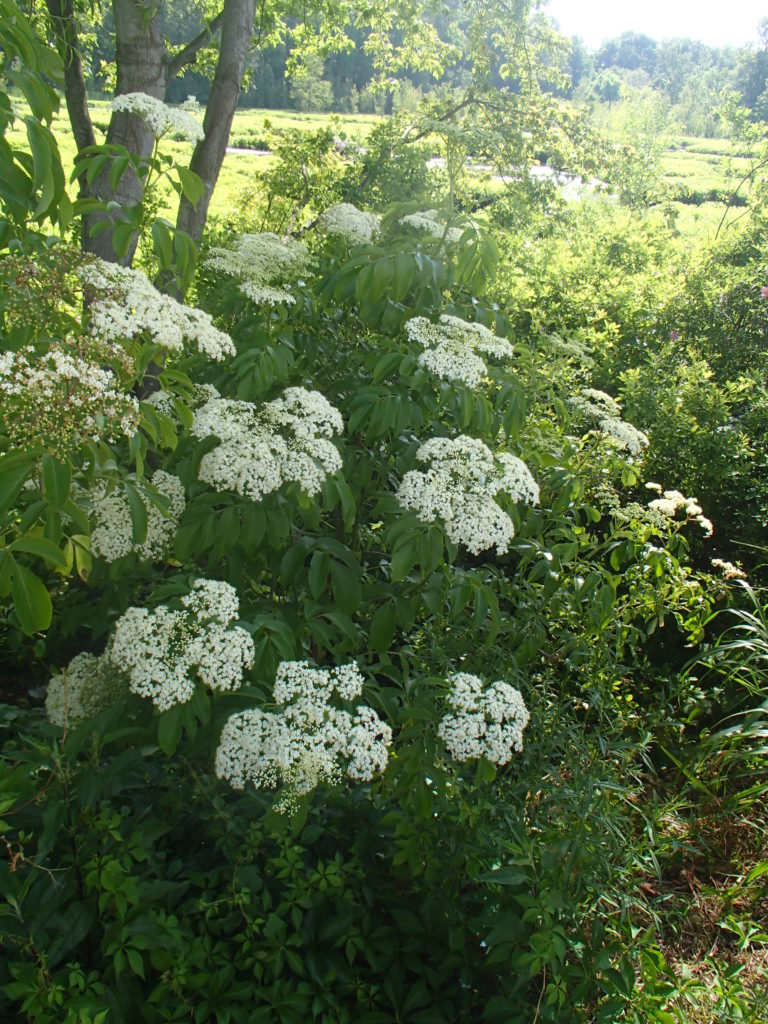Elderberry is a vigorous, beautiful shrub commonly observed on roadsides and in hedgerows and disturbed areas in most NC counties and most states as well. It is a a vigorous grower, 5-12′ in height and spread, with arching branches which support numerous flat-topped white flower clusters in mid-summer. These retain their beauty as they turn golden brown as the season progresses. Finally dark blue-black berries are produced in drooping clusters on pinkish purple stems. Elderberry is a great looking addition to a naturalized landscape, but it is also a wonderful starter plant for those interested in incorporating edible native plants into their homestead. The flowers are edible (elderflower fritters), but most folks grow the plant for its berries, which are famous for being high in nutrients and antioxidants. They are used to make juice, jams and jellies, and of course Elderberry wine. While a vigorous grower, it responds well to heavy pruning. Individual shrubs are relatively short lived, but new plants from root sprouts are readily available for replacement. Easily maintained and problem free, Elderberry attracts numerous pollinators and hungry birds and even provides nesting materials for birds. It is a remarkable, useful, and beautiful plant, often taken for granted and casually destroyed in spite of its great value for wildlife.
NURSERY HOURS
Wednesday: 10-4 Thursday: 10-6 Friday-Saturday: 10-4 Sunday: 12-4
Sambucus canadensis (synonym Sambucus nigra ssp. canadensis)

Key Info
Scientific Name: Sambucus canadensis (synonym Sambucus nigra ssp. canadensis)
Common Names: Common Elderberry, Black Elder, Mexican Elderberry, Tapiro, Sauco
Family Names: Caprifoliaceae
Plant Type: Tree / Shrub
Leaf Retention: Deciduous
Flower Color: White
Special Characteristics: Fast growing, Edible fruit (in jams), Flowers fragrant (musty), Rhizomatous, Showy fruit, Attracts bees, Attracts butterflies, Medicinal value, Edible flowers, Attracts birds
Additional Info
Habit: Elderberry is a medium textured, graceful, sprawling, multi-stemmed, suckering shrub with both woody and herbacious branching. The stems usually have an arching habit, creating a loose, broad crown. Its bark is smooth and brown, becoming shallowly furrowed and rough with age. The root system is shallow and rhizomatous. Clonal offsets often develop from the spreading rhizomes to form colonies.
Height: 6' to 12'
Spread: 6' to 12'
Soil Conditions: Medium to wet, well drained humusy; acid pH but pH adaptable; tolerates a wide range of soils, Clay Soil, Loamy Soil, Sandy soil if moist.
Leaves: Opposite, coarse, compound dark green leaves consisting of a central axis with 4 to 10 (usually 4 to 6) paired leaflets (pinnate) and a terminal one often larger. Leaflets ovate to elliptic or narrower, up to 7 inches long, with a broadly wedge-shaped base, margins toothed except at the tip and toward the base, the teeth narrow and pointed toward the tip. It shows a yellow-green fall color.
Flowers (or reproductive structures: Flowers occur May to July. Tiny lemon-scented white flowers are borne in showy cymes 6" to 10 " across. Immature inflorescences are flattened above, but later these become more dome-shaped. Each flower spans up to ¼ inch across, consisting of a short cup-shaped light green calyx, a white corolla with 5 spreading petals, 5 exserted stamens, and an ovary with 3 short styles. (Illinois wildflowers.info) Elderberry flowers are self-fertile and only one plant is needed for bountiful fruiting. There is a strong fragrance that is considered sweet, but with musty overtones.
Fruit: These edible berries, occurring in drooping clusters in the fall, are a little less than ¼ inch across, dark purple to black, glabrous, and more or less spherical in shape, with a juicy interior and containing 3-5 small seeds. Their flavor is sweet, although with a slightly bitter aftertaste.
Natural Distribution: Streambanks, ditches, old fields, fence tows and roadsides; weedy in disturbed areas Common Elderberry is a pioneer species that is often found in habitats with a history of disturbance.
USDA Hardiness Zone: 4 to 9
USDA Wetland Indicator Status in NC: Not available.
Pollination: Bees, butterflies, other insects.
Wildlife Connections: Elderberry flowers provide only pollen as a floral reward to insect visitors such as bees, flies, and beetles; some bees construct nests for their larvae by tunneling into the soft pith of broken stems; a number of insects feed on the leaves, stems and roots; birds that eat the small fruits include the Ruffed Grouse, Ring-necked Pheasant, Greater Prairie Chicken, Eastern Bluebird, Northern Cardinal, Gray Catbird, Northern Mockingbird, American Robin, House Finch, Wood Thrush, Red-eyed Vireo, Cedar Waxwing, and White-throated Sparrow. Mammals that consume the fruits include squirrels, mice, turtles and rabbits (Illinoiswildflower.info).
Propagation: By seed (seeds need to be scarified and stratified to germinate the first year); by division; by softwood and semi-hardwood cuttings.
